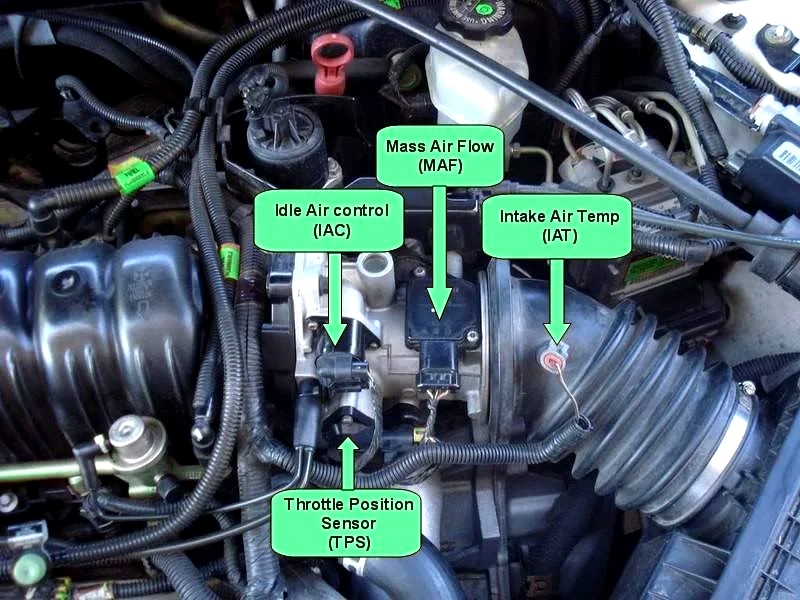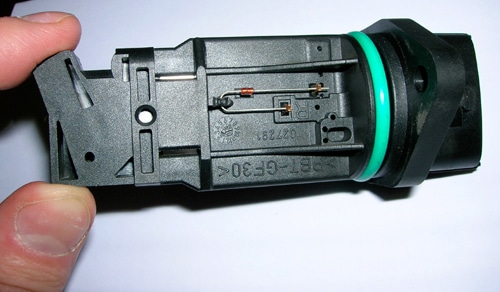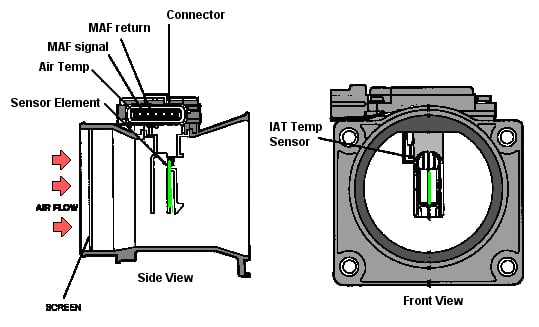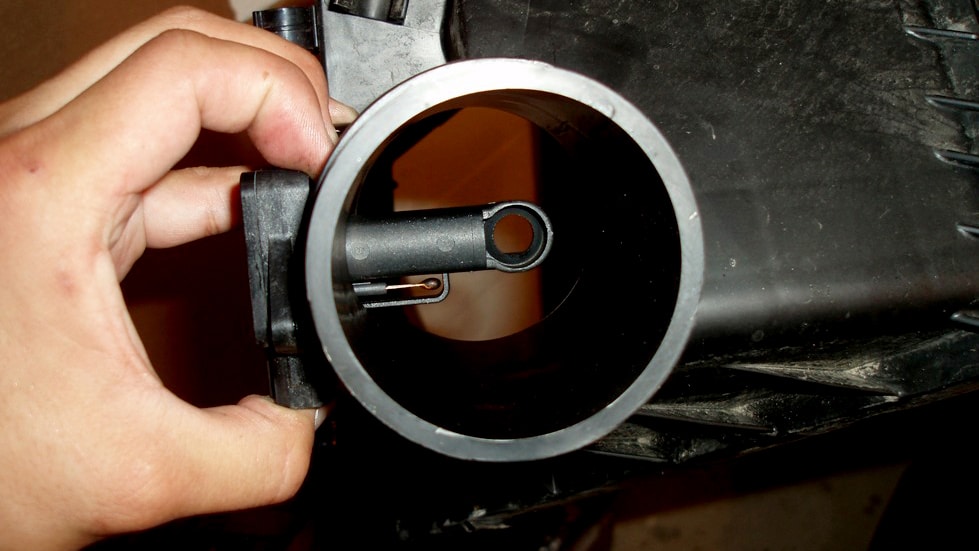Modern cars rely a lot on electronic hardware. The use of electrical sensors and control units has made it possible for us to diagnose, measure, and modulate vital functions of the car more quickly and efficiently than ever before.
It’s no wonder why modern engines are so complex. There’s a sensor for everything: measuring oxygen, vital fluids, engine speed, spark knock, camshaft position, crankshaft position, and so much more.
Arguably among the simplest yet most important ones is the mass air flow or ‘MAF’ sensors.
In this article, we’ll discuss how mass air flow sensors work, how much they cost to replace, and how you can tell when it’s failing.
How Does the MAF Sensor Work?

The MAF sensor has one main purpose: to calculate the amount of air entering an engine. It’s usually located in the intake pipe, between the air filter housing and the intake manifold.
MAF sensors are of two main types:
- hot wire (electrical), and
- vane meter (mechanical).
We’re focusing exclusively on hot wire sensors in this post considering how they’re the industry standard.
Hot wire MAF sensors have two main components:
- an electrically heated element (hot wire), and
- an IAT (intake air temperature) sensor for calculating the temperature of the air around the hot wire.

Here’s what happens when the MAF sensor is in action — as the incoming air goes through the intake system, it passes over the pre-heated wire in the MAF sensor. As a result, the wire starts to cool down.
When that happens, the IAT sensor records the temperature difference and sends that information to the ECU which then increases the current to keep the wire hot.
The higher the air flow, the more electrical current is needed to keep the heating element hot.
For instance, if the engine is idling, only a small amount of air flows over the hot wire, so it doesn’t need a lot of current to keep the wire hot.

But when you’re stepping on the gas, the amount of air drawn by the engine is much higher, so the current needed to keep the wire hot increases accordingly.
You’re probably wondering why we’re discussing electrical current when the topic at hand is about air flow.
Interestingly, the hot wires or heating elements used in MAF sensors are made of resistive platinum. The cool thing about this material is that as its temperature increases, so does its resistance.
This means that as its temperature decreases, its also resistance decreases. According to Ohm’s law, voltage and current are directly proportional.

So when the resistance goes down, it allows more electricity to pass through. In other words, when more air passes through, the system sends more electricity to the wire. So we have air flow directly proportional to the amount of current supplied.
The change in current is interpreted as a change in voltage, which is then sent to the ECU. The ECU uses the air flow signal to calculate how much fuel to inject — keeping the air/fuel ratio in check as a result.
What Happens When a Mass Air Flow Sensor Breaks?
Identifying a malfunctioning MAF sensor is as easy as detecting the symptoms of bad spark plugs. In fact, the two have similar signs of failure
The biggest problem that arises when the MAF sensor fails is that the ECU won’t know how to control the air-fuel mix inside the engine.

When the air flow rate is unknown, the ECU miscalculates the fuel requirement which snowballs into a whole list of different problems. Some of these include:
- Incorrect AFR ratio
- Engine knocking
- Damaged O2 sensors
- Damaged catalytic converter (unless you have test pipes installed)
- Choppy throttle
- Poor gas mileage
In some engines, a failed mass air flow sensor can cause the engine to crank but not start. Make sure to install MAF sensors properly, as improper installation can cause them to go out sooner.
The hot wires inside these sensors are notorious for accumulating debris, air filter fibers, dust, oil, and pollen.
When they get dirty, they provide inaccurate readings to the ECU, and so they need to be cleaned on a regular basis. We recommend using only use the best MAF cleaners for this purpose.

Also, if your air filter is of the washable type, make sure to not over-soak it as it can damage the mass air flow sensor. Listed below are some possible symptoms of a falling unit.
Symptoms of MAF Sensor Failure
As the MAF sensor gets contaminated or starts to fail for other reasons, you’ll notice several drivability issues with your car. Problems range from rough idling to increased fuel consumption.
Other noticeable issues include difficulty starting the engine, hesitation to accelerate, and engine drag under load.
Additionally, if you notice the engine jerking under acceleration, chances are the MAF sensor is on its way out. Rich or lean idling can also be attributed to a failing mass air flow sensor.

As mentioned, if the system finds problems communicating with the sensor, the ECU will throw a check engine light (caused by diagnostic error codes P0100-P0105) and can even engage limp-home mode.
If you’ve started to experience some of these signs, it’s best to get the MAF sensor tested. However, to test whether it’s functioning correctly is not that simple.
In modern cars, the only way to test the mass air flow sensor is with a scan tool.
The goal is to check whether your MAF sensor is showing a lower air flow reading versus a normally functioning sensor.
That said, low mass air flow readings do not mean the sensor is bad. Vacuum leaks, a clogged-up air filter, or plugged catalytic converter can also cause faulty readings.
Simply cleaning the sensor can help, but make sure to do it properly. If none of these is the culprit, you may have to replace the MAF sensor.
How Much Do Replacements Cost?

The price of a replacement MAF sensor depends on whether you’re wanting to buy an OEM replacement or an aftermarket unit. The replacement cost of a mass air flow sensor can range from $89 to $380.
However, some high-end OEM MAF sensors can set you back by $300 excluding installation charges. For a Porsche Cayenne, the MAF sensor costs $625. Aftermarket MAF sensors, on the other hand, are relatively cheaper.
Concluding Thoughts
As long as you keep your MAF sensor clean and keep an eye out for the symptoms listed above, it will last for several thousand miles.
Replacing a MAF sensor is pretty simple too. As mentioned earlier, it’s located between the air filter housing and the intake manifold.ma You can use a flat-head screwdriver to pluck it out.
Also, it’s recommended that you swap out the existing air filter if you’re replacing the MAF sensor.
What type of MAF sensor do you have on your car? Let us know by leaving a comment below!
If you enjoyed reading this article, don’t forget to share it on Reddit, Facebook, or your favorite car forums! We appreciate your support.

